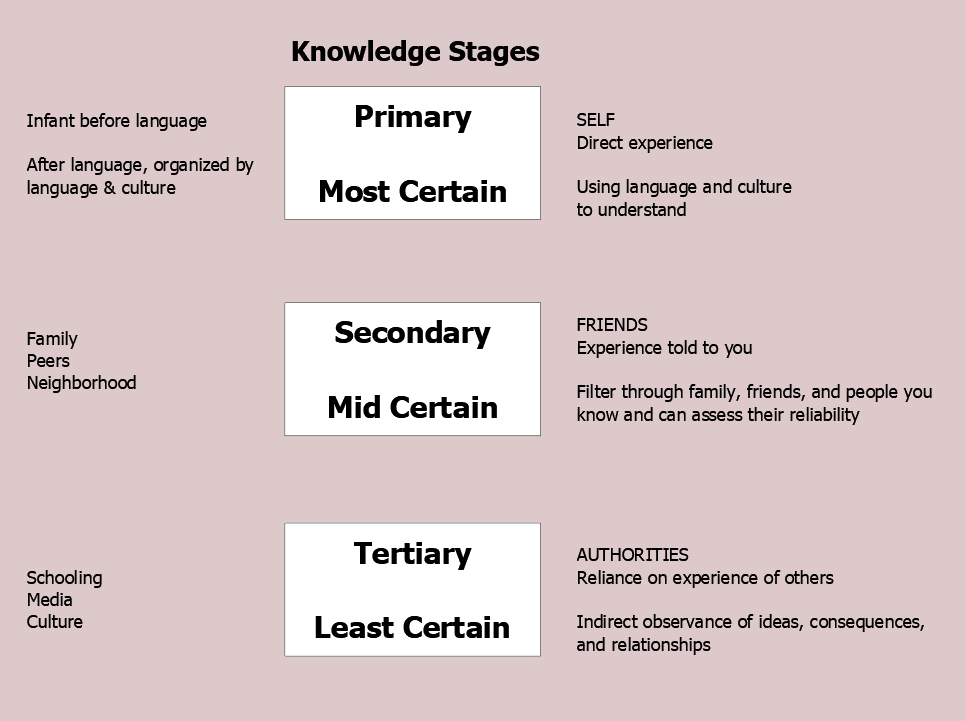Basic biological stages are linked with knowledge categorization stages. Important threads reveal themselves.

Starting from the top of the diagram:
Primary, Personal Knowledge
This is immediate knowledge which we accept no matter what others say. The nascent human brain, shaped by genetics, shuttles sense data to the cortical, sensory lobes. Neurons, by Hebb’s Law, arrange repeated sensory data into distinct patterns. Before we understand language, we arrange perceptions according to our own idiosyncratic genetics and experience. These inchoate patterns are the substrate upon which we arrange words as our facility grows. With language we organize our knowledge into shared categories. Our immediate experience remains bedrock truth, although sometimes we may chaff at its poor fit to verbal statement.
Secondary, Familial Knowledge
As we physically grow from infancy to puberty, the development of our hippocampus (age 2-5) allows us to store memories. Also in our brain’s limbic system, the amygdala melds our 3S imperatives (Satiety, Sex, Safety) with the opportunities and dangers of our experiences into the emotion traits of our personalities.
During infancy up to schooling, the family provides important second-hand information about the world. We know how they act around us, so we learn who is telling the truth about things they tell us, who shades things, and who makes things up. The relations between people, how they solve disputes, and our place in society is told to us daily and in innumerable ways.
Second-hand information broadens our knowledge, but it is not as reliable as immediate experience.
Once we start schooling, we meet children our own age who can have dramatically different views of normal actions and behaviors. We know them less well than family, so that assess the truth in what they say is more difficult.
Teachers present a separate expansion of our knowledge. They impart to us essential information, which we have to accept. The basic knowledge is conventional–the alphabet, numbers, reading from left-to-right, top-to-bottom. Later, the knowledge becomes normative–that is good, that is bad–for instance in history. We don’t the teacher, resulting in an inability to tell when the teacher is shading the truth. Fortunately, most elementary school teachers are well-intentioned.
Once we enter puberty, the social group becomes a prime source for wider experience, beyond what we can experience, but we still retain a predominance of immediate and secondary information sources.
The traits developed in this stage are assembled atop our primary knowledge. In a like way, this secondary knowledge becomes the flooring for tertiary knowledge.
Tertiary, Societal Knowledge
As we advance to high school, the academic content increases. The material engages our ability to learn abstract concepts and how they relate to each other. More of the mental work is in the frontal lobes with its advanced executive and decision-making capabilities.
The knowledge being transmitted is based on the experience of our teachers, but of information they have learned. The knowledge is not immediate. It is not secondary. It is tertiary. Our ability to evaluate this knowledge is stretched far from personal experience. It is built upon (in our minds) the immediate sensations and second-hand experiences we have learned to this point. For us, the knowledge has a probability of truth rather than a certainty. There are a passel of assumptions and experiences which are necessary for a physicist to utter, “We know everything but the first thirtieth second after the Big Bang.”
With tertiary knowledge, you have to make a decision on what authorities you are going to believe.
Of course, once you finish school, you will continue to be exposed to authorities speaking of things you have no direct knowledge of. The media. The vast news companies, the fringe groups who can mount their own news channels, and tech giants which present answers to our questions on the internet.
We assess their reliability on our personal experience now and especially on the building blocks that formed when our mind and knowledge was being first formed.
Surprisingly, the executive areas in the prefrontal lobes are not fully connected (with myelinated axons) to other parts of the cortex until our late 20s. Until that is accomplished, the immediate demands of our emotions can outweigh the constraints our rational thought may wish to impose.
Morality in Biological Stage
The knowledge we acquire in infancy is immediate. It’s limited, yet we are undeniably sure of it. Our morality is a pain-and-pleasure principle. If it feels good, it is good. If it hurts, it is bad.
During growth, our knowledge is colored by morality enforced by our parent’s power. Morality is governed by might-makes-right. The parent’s belief is right. If you disagree or disobey, you will be punished. If you accept their proclamations, you will be rewarded or, at least, not punished.
During puberty, when you are out of the house a lot, the norms are those of the neighborhood and peers. Moral assessment of behavior becomes looser. Everything you does not come to your parent’s attention. Often morality becomes that which you can get away with.
In adolescence, legalistic or logical morality is in ascendancy. An act’s morality is determined by its fit within a set of rules.
After the cortex has all its areas inter-communicating, it is possible to look for morality in one’s internal beliefs rather than society’s or government’s.
The Decision model shows how knowledge and morality affect an adult’s reasoning.
